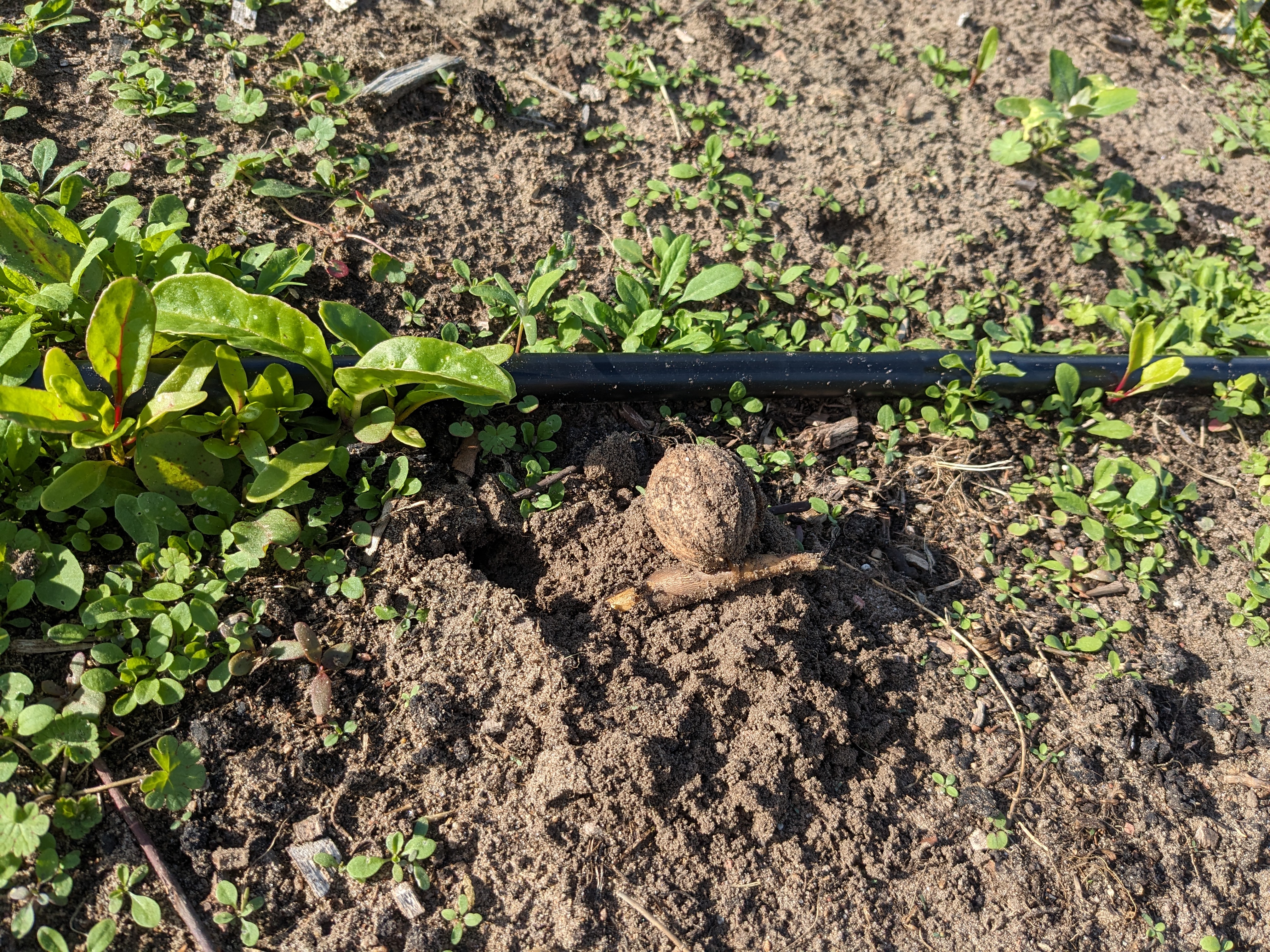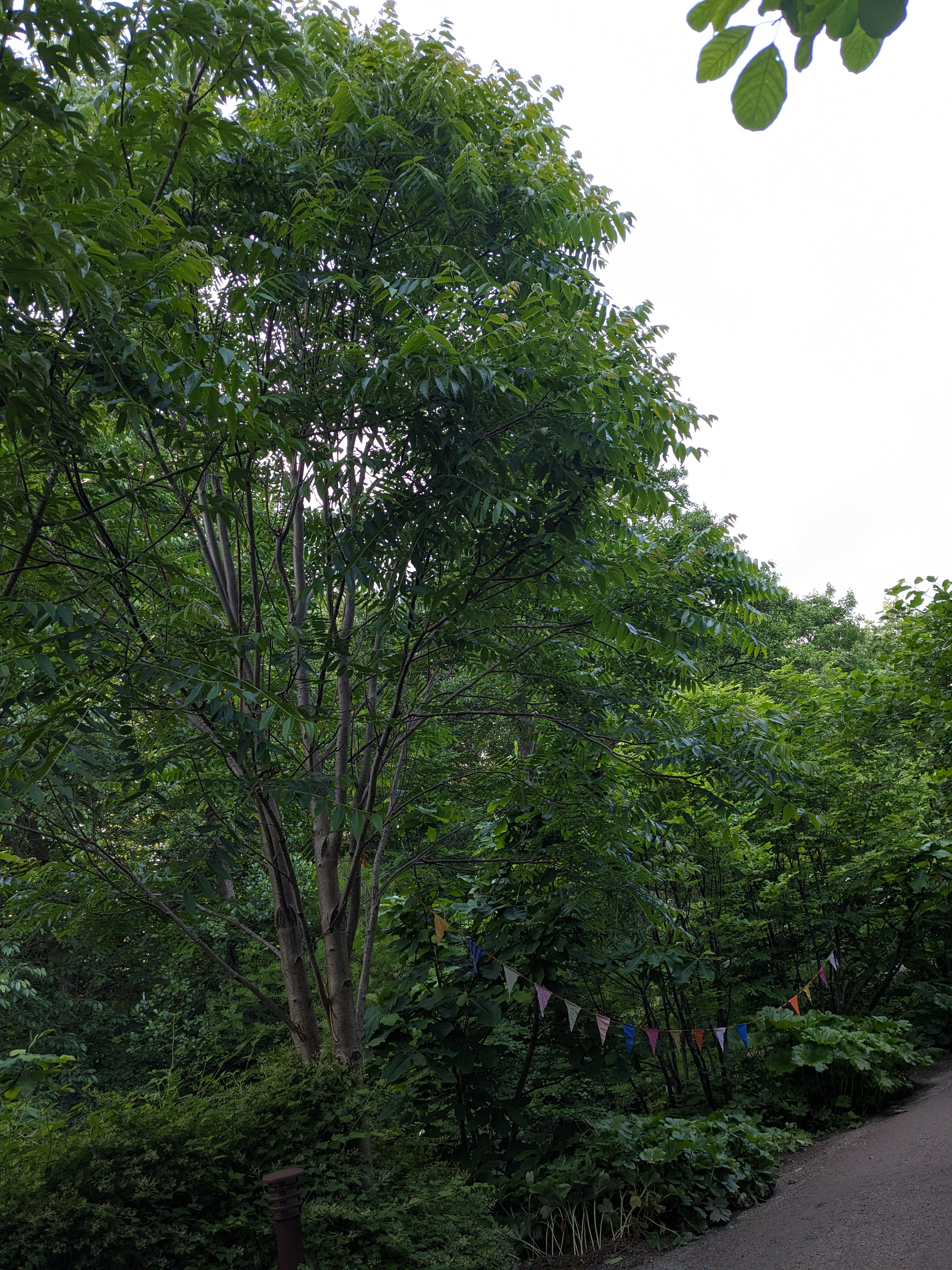June pruning?
In the entertaining book "Fruit for Life" by Tim Foster, he tells about the old rhyme to prune the prunes (e.g. plums, cherries, abricots etc.) in June. The old cherry tree gave two cherries this year, and they are long gone, so now would be a good time to reshape and give more light to next year's flowers. But the plums are far from ripe, so I let them hang and wait until harvest is done before I take out the secateurs to clean up the wild growth.
The days are long and the weather is great - rain every second day - so everything grows like crazy. Including the weeds... I am so happy that we could clean up in many places during April and May and protect the soil with woodchips to reduce weed pressure. Our most excellent intern Jane did a great job.
Trees for life
Air pruning
The walnuts grow great in the air-prune beds. We have to water them separately, they are one of the few crops that is not connected to a dripline. The fact that we have to give them water make us go there more often. The more I watch them and can remove small weeds early, the less work it is later.
 Small walnut trees - to graft on next April.
Small walnut trees - to graft on next April.
Chestnuts bud out
The chestnut trees that we grafted in May have budded out. Some budded out after a week or two, but some only come now, seven weeks later. I think these ones had only "dormant buds" under the skin, which is why they took some time to develop.
 Chestnut budding out, seven weeks after grafting.
Chestnut budding out, seven weeks after grafting.
Stolen fruit
We tried this year to sow Japanese walnuts outside, in a garden bed. Our neighbours, the rooks, found them and had a large walk-in buffet of nuts and young nut trees.
I love biodiversity and the rooks, but next year I have to figure out something to keep them away. Maybe a net above the nursery bed, and some free-to-eat nuts on the side for the rooks?
 The rooks dig out the small trees.
The rooks dig out the small trees.
 Sometimes they eat half the nut and come back next day for the other half.
Sometimes they eat half the nut and come back next day for the other half.
Edible park in town
We live in a small and picturesque town, with a beautiful central garden. Lots of people enjoy this place, and I am happy to see all the edible trees that have been planted. Not only chestnut and walnut trees, but also American pawpaw and Asian onion-tree.
 Pawpaw tree - with light and drooping leaves. No blossoms yet, but in a few years, this tree will give lots of great fruit.
Pawpaw tree - with light and drooping leaves. No blossoms yet, but in a few years, this tree will give lots of great fruit.
 Along the bike path, there is a magnificent Toona sinensis - a vegetable tree. The young leaves are used in cooking, quite a lot like leek.
Along the bike path, there is a magnificent Toona sinensis - a vegetable tree. The young leaves are used in cooking, quite a lot like leek.
Botanical expertise
We joined the local Nature conservancy group ("Naturskyddsföreningen") and have been on a few excursions to see plants and hear stories. It is amazing how knowledgeable some people are about the little mosses and ferns and lichen and beach cabbage.
 Our guide, Lars-Erik shows the water cress groing wild in the artesian well, not far from the sea.
Our guide, Lars-Erik shows the water cress groing wild in the artesian well, not far from the sea.
 The main focus on trips like this are on the rarities. This blue flower is "spiked speedwell", which sound more like a snorting drug than a flower.
The main focus on trips like this are on the rarities. This blue flower is "spiked speedwell", which sound more like a snorting drug than a flower.
Larger than life
We encounter life in many forms on the farm. When we picked up a load of old organic cow manure from our friend Gun's farm, we found this huge caterpillar.
 E. shows the caterpillar.
E. shows the caterpillar.
 It is the largest caterpillar that we have seen so far.
It is the largest caterpillar that we have seen so far.
Death is everywhere
The agricultural area around our place is industrial, for about 10km in every direction, with minor gaps and occasional hedgerows. Every week, we see different fields being sprayed. The worst fields are the sugar beet and potatoe fields, where the sprayers drive over every other week throughout the summer. Especially when there is rain, fungi are ready to attack, which means that the sprayers are not far behind. When some organisms die, others also die.
All this toxic poison leaches through the sandy soil into the ground water and into the river and the ocean.
Anyone thinking about consequences?
 Typical effect of selective herbicides, where the corn keeps growing and everything else withers.
Typical effect of selective herbicides, where the corn keeps growing and everything else withers.
Home made fertilizer
We visited an amazing couple who live five kilomters from us. For 25 years, they have been using composting toilets with urine diversion. All their amazing garden is fertilized with home made golden water. They had an ingenious system with free downhill flow. Their houses and loos are located on the highest point in the garden, and from there, the urine flows in tubes into tanks that can be accessed directly from the garden. No carrying of buckets like we do. Very ergonomic and hygienic.
 Jan-Erik shows us how the tanks are connected and how the irrigation works. This is the future!
Jan-Erik shows us how the tanks are connected and how the irrigation works. This is the future!